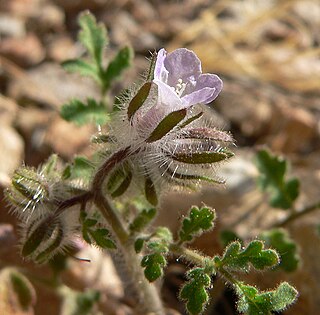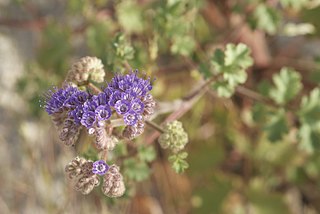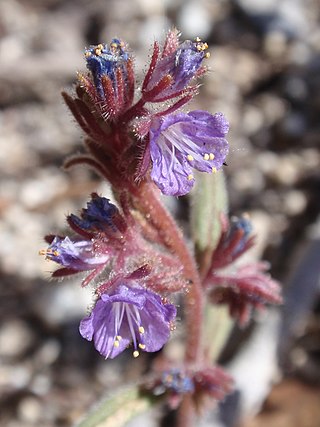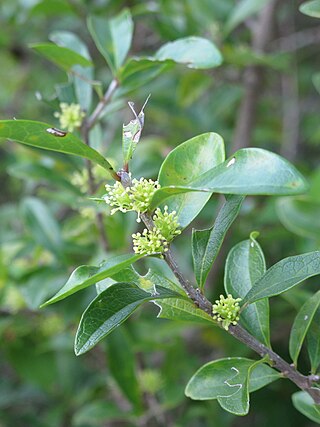
Phacelia crenulata is a species of flowering plant in the waterleaf family, Hydrophyllaceae. Its common names include notch-leaf scorpion-weed, notch-leaved phacelia, cleftleaf wildheliotrope, and heliotrope phacelia. Phacelia crenulata has an antitropical distribution, a type of disjunct distribution where a species exists at comparable latitudes on opposite sides of the equator, but not at the tropics. In North America, it is native to the southwestern United States as far east as Colorado and New Mexico, and Baja California and Sonora in Mexico. In South America, it is native to southern Peru, western Bolivia, and northern Chile.

Phacelia fremontii is a flowering plant in the family Boraginaceae native to the southwestern United States. In California, its range includes the Mojave Desert, the San Joaquin Valley, the Coast Ranges, and the Sierra Nevada. It was named for John C. Frémont.

Phacelia minor, with the common names Whitlavia and wild Canterbury bells, is a species of flowering plant in the family Boraginaceae. It is native to Southern California and Baja California, where it grows in the Colorado Desert and the coastal and inland mountains of the Transverse-Peninsular Ranges, often in chaparral and areas recently burned.

Palafoxia arida is a species of flowering plant in the aster family, known by the common names desert palafox and Spanish needle.

Phacelia breweri is a species of phacelia known by the common name Brewer's phacelia.

Phacelia cryptantha is a species of flowering plant in the borage family, Boraginaceae, known by the common name hiddenflower phacelia. It is native to the southwestern United States and Baja California in Mexico, where it grows in several habitat types in desert, rocky mountain slopes, canyons, plateau, and other areas.

Phacelia humilis, with the common name low phacelia, is a species of phacelia. It is native to the Western United States, from central Washington to central California, where it grows in mountain and foothill habitat.

Phacelia insularis, the coast phacelia is a rare species of phacelia. It is endemic to California, where it has a disjunct distribution.
Phacelia inundata is a species of phacelia known by the common names playa yellow phacelia and playa phacelia. It is native to the Modoc Plateau and surrounding areas in Oregon, western Nevada, and northeastern California, where it grows in the alkaline soils of playas and dry lakebeds.

Phacelia linearis, the linear-leaved phacelia or threadleaf phacelia, is a species of phacelia.
Phacelia longipes is a species of phacelia known by the common name longstalk phacelia. It is endemic to California, where it grows in the Transverse Ranges and adjacent western Mojave Desert. Its habitat includes chaparral, woodland, and forest, in rocky soils.

Phacelia nashiana is a species of phacelia known by the common name Charlotte's phacelia. It is endemic to California, where it is known only from the ecotone where the lower Sierra Nevada and Tehachapi Mountains transition into the Mojave Desert. It grows in scrub and woodland and on granite mountain slopes.

Phacelia pedicellata is a species of flowering plant in the borage family, Boraginaceae. Its common names include specter phacelia and pedicellate phacelia. It is native to the southwestern United States and Baja California, where it can be found in several types of habitat, including creosote bush scrub and Joshua tree woodland.

Phacelia quickii is a species of phacelia known by the common name Quick's phacelia.

Phacelia ramosissima is a species of phacelia known by the common name branching phacelia. It is native to western North America from British Columbia to California and the Southwestern United States, where it can be found in many types of habitat.

Phacelia stellaris is a rare species of flowering plant in the borage family, Boraginaceae, known by the common names star phacelia and Brand's phacelia.

Phacelia viscida is a species of phacelia known by the common names sticky phacelia and tacky phacelia.

Salvia munzii is a semi-evergreen perennial species of sage known by the common name Munz's sage or San Miguel Mountain sage. It is native to northern Baja California, Mexico, and it can be found in a few locations just north of the border in San Diego County, California, where it is particularly rare. It is characterized by small leaves and clear blue flowers. It is a member of the coastal sage scrub and chaparral plant communities.

Echinocactus horizonthalonius is a species of cactus known by several common names, including devilshead, turk's head cactus, blue barrel cactus, eagle's claw, horse maimer, horse crippler, and visnaga meloncillo. It is native to the southwestern United States and northern Mexico, where it occurs in Chihuahuan Desert and Sonoran Desert habitats, particularly on limestone substrates. One of its varieties is a federally listed endangered species of the United States.

Forestiera segregata is a species of flowering plant in the olive family known by the common names Florida privet, Florida swampprivet, and southern privet. It is native to the Bahamas, the Greater Antilles, including Puerto Rico and the Cayman Islands, the Lesser Antilles, including Anguilla, and Florida, Georgia, and South Carolina in the United States.























